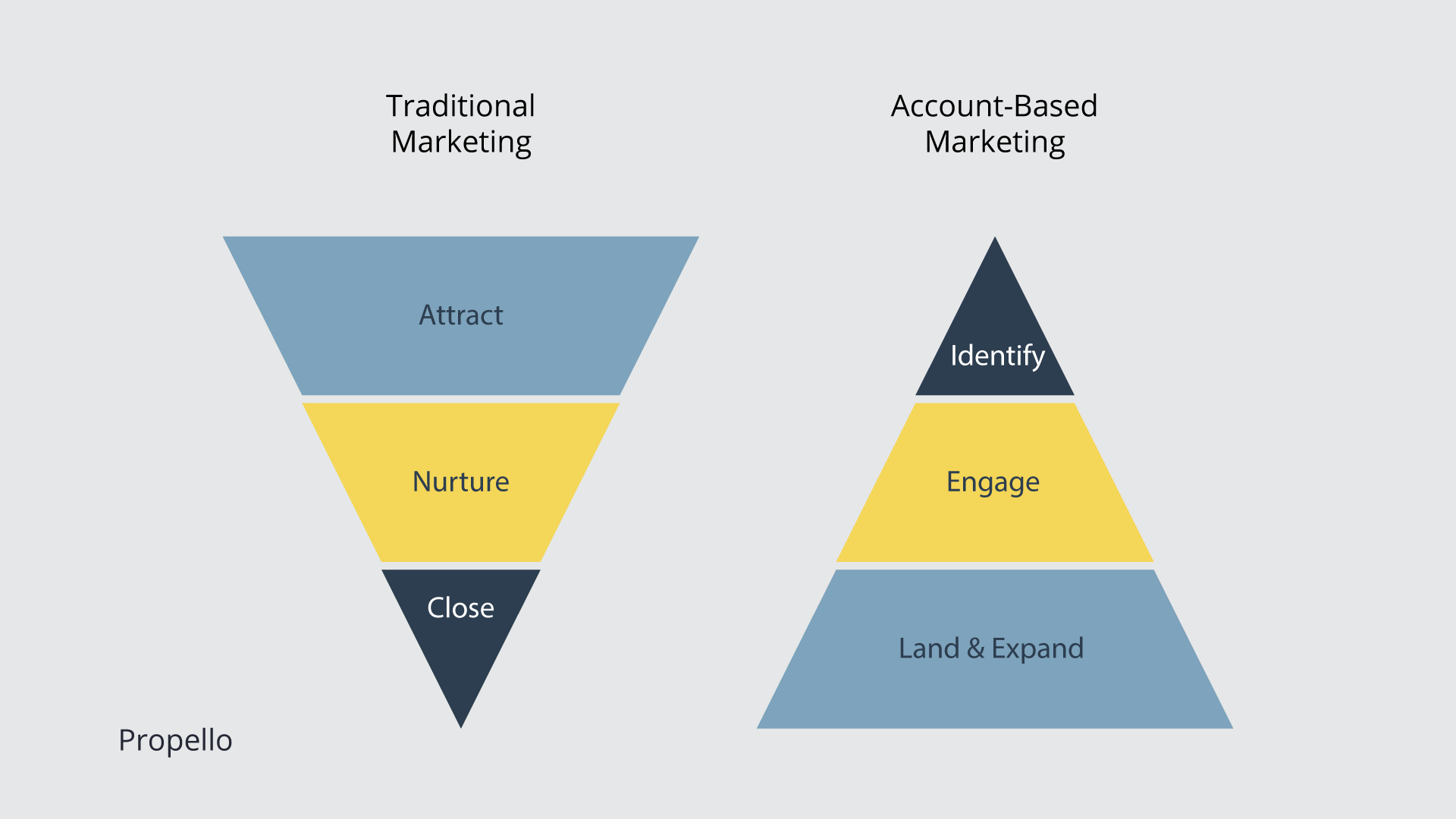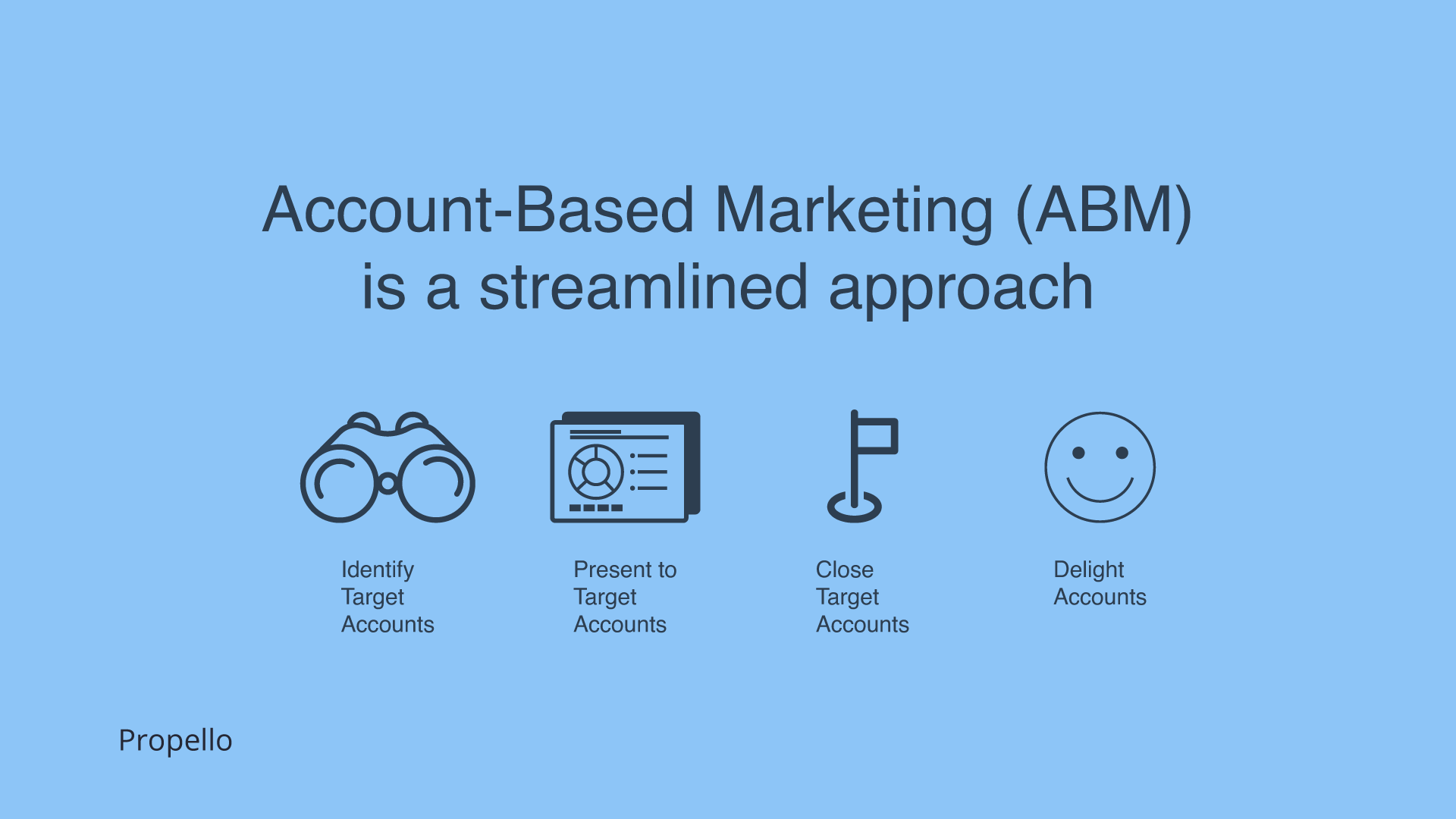Account-based marketing is a new way of thinking about customer relationships.
Imagine a future where you can sell directly to your best-fitting, highest-value customers. You won't waste any time trying to market to non-qualified leads who aren't the right fit for your company. Instead, you'll get straight into the phases of engagement and delighting your target customers.
Now that is real efficiency!
Account-based marketing helps you identify less valuable companies early on so that the Marketing and Sales teams are in complete alignment. As a result, your team can leap right into the critical processes of engagement and delighting those accounts.
ABM enables businesses to work and communicate with high-value accounts as if they were individual markets. By doing so, ABM empowers marketers to get closer to customers and increase customer retention. ABM also allows them to personalize the buyer’s journey and tailor every communication, content, and campaign to each account.
| Account-Based Marketing Account-based marketing (ABM) is a focused growth strategy in which Marketing and Sales collaborate to create personalized buying experiences for a mutually-identified set of high-value accounts. |
What is Account-Based Marketing?
Account-based marketing is a focused growth strategy where Marketing and Sales collaborate to develop personalized customer experiences for a mutually identified set of high-value customers.
Before we take a closer look at the additional benefits and specific tactics you can use to improve your account-based marketing efforts, let’s first review their relationship with another essential strategy, inbound marketing.
Account-Based Marketing and Inbound Marketing
When used together, account-based marketing and inbound marketing are powerful tools that have the potential to grow your business.
In fact, when used together, these two strategies will help you build stronger relationships with your most important customers.
So how does this partnership work exactly?
We've now covered the definition of account-based marketing. As you know, ABM is a highly-targeted strategy.
Meanwhile, inbound methods are more foundational than outbound ones. They allow companies to attract visitors by creating unique and valuable content, optimizing their sites for search engines, and delivering an amazing user experience.
Rather than interrupting people who might be interested in your product or service, inbound marketing allows you more organically provide them with the information they want whenever they want it.
To start, inbound lays the groundwork for a successful ABM strategy by allowing for highly-targeted and efficient resource allocation of high-value accounts. There are several additional benefits to implementing both inbound and ABM in your organization:
- With inbound marketing, you attract target accounts and use ABM to accelerate the flywheel so you win and delight those accounts with a memorable customer experience.
- Marketing lays the groundwork for an effective ABM strategy — ABMs build on top of inbound marketing by allowing for targeted and effective resource allocation of high-value accounts.
- Using this combined approach, you'll be able to attract a broader group of potential clients than if you were to use just one method.
- You can create content that serves both an Account Based Marketing (ABM) and inbound marketing strategy. For example, you can create a personalized case study that you share on your website.
- Software such as HubSpot exists to help you implement ABM and inbound strategies in a complementary manner.
Account-Based Marketing Framework
Account-Based Marketing (ABM) works differently than a traditional sales funnel. While ABM can be applied across various industries and business models, some key components need to be considered when implementing it. Here are the main components of an account-based marketing framework:
Marketing-Sales Alignment
Marketing and Sales need to work together to create a successful strategy for ABM. Without a strong partnership, you won’t get the results you expect. Marketing should understand what sales need and help them achieve their goals. Sales should listen to the marketer and provide insights into customer behavior. Both teams should collaborate to build a plan that will drive profitable growth.
Sales and Marketing teams need to agree upon which resources they'll allocate to each target account, assigning specific roles and responsibilities to ensure an effective transition for the customer between sales and marketing activities, and determine how to measure the success.
Account Qualification
How does the company create an ideal customer profile for its accounts? Marketing and Sales need to participate in these conversations. Creating an ideal customer profile helps companies understand the needs of their customers and create a targeted approach to reach them.
When determining which accounts qualify for your list, consider these factors:
- Financials: When considering your company’s financial goals, think about how much revenue can be earned from an account.
- Scalability: Based on what you understand about the potential customer’s business performance and growth, is there potential to increase the size of the account? Consider adding additional services to help the customer grow and retain the account.
- Competitive landscape: What are your competitors doing right now? Are they selling similar products to what you're offering? Do they offer any services that you could use? Knowing what your competition is doing will give you an idea of where to focus your efforts.
Go-to-Market Approach
Once marketing and sales align on approach and which accounts they want to target, it‘s time to develop a go-to-market plan.
Understand how your customers move through the buying cycle. You will find that there are many different stages in the buying journey that you can influence. By understanding the stages and the interactions between them, you will be able to create a stronger relationship with your customers.
Furthermore, because a personalized experience has become so important in account-based marketing, your team will need to look out for additional ways to add extra value and deliver a premium customer experience to these accounts.

Account-Based Marketing Strategy
To get the most from an account-based marketing strategy, you’ll first need to develop one. Then consider implementing the following steps to create and implement a successful account-based marketing strategy:
1. Create alignment between your sales and marketing teams
Marketing and sales alignment is essential for successful account-based marketing implementation. To create a custom buying experience for customers, you must ensure a seamless transition from being an acquired lead to becoming a customer.
To improve synergy between marketing and sales, both teams need to commit to clear communication and find a common ground to ensure that the marketing team is acquiring the right leads for the sales team to convert into sales opportunities.
If you're just starting with ABM, having one marketer and one account rep working together to identify and close deals is enough. As your efforts grow, prioritize having your marketers support additional salespeople, since one marketer can typically align with up to 10 salespeople, and each salesperson should align with up to 10 accounts.
2. Conduct research to determine account personas
Once marketing and sales agree on their approach, they can work together to ensure that your company targets the right account personas.
First, you need to conduct some research to figure out what type of accounts you want to target. When identifying buyer personas for an account-based marketing strategy, marketers should consider:
- The mission, vision, and business objectives of their ideal customer.
- If any high-value accounts are currently engaging with your company’s Inbound strategy.
- The current stage of business maturity, company size, and growth trajectory.
- The revenue model, and spending patterns
- The tools and platforms their ideal customer is currently using.
There are countless ways to identify the key accounts, but what’s most important is that marketing and sales agree on the accounts to target.
Professor Kyle Jepson, at HubSpot, warns, "If your marketing is targeting a single list of companies, and if your salespeople are working with a different list of companies, you're likely to end up with an accounts-based mess."
3. Create account plans
Once you've determined which accounts to target, it's time to create an account plan for each one. A good account plan requires both marketing and sales teams to work together to map out the leads they will need to acquire to reach their targets, and what content they will need to post to engage with these audiences.
To create an effective account plan for your ABM strategy, follow these best practices:
- Each account plan should be tailored to meet the unique needs of that particular customer.
- Each account should be able to answer these two questions: Who will be included in the buying decision? What content will be required for each member of this decision-making team?
4. Attract contacts associated with target accounts
You should ideally use the Inbound methodology to attract contacts who are already looking for your type of solution. However, if you're having trouble attracting new leads, then you may want to consider determining which channels your ideal contacts are currently using to look for a solution and make sure your company appears there.
You can reach out to your contacts using different channels. Events, industry publications, and targeted advertising are just a few options. You should prioritize the channels that are best suited to your target accounts and contact lists.
5. Get the buying committee involved
As you build relationships with key contacts, make sure both sales and marketing teams are actively engaging people who will be involved in making the buying decision.
Marketing should always be prepared for the possibility of supporting sales efforts by creating relevant content to reinforce messages.
To evaluate the success of an ABM strategy for marketing and sales teams, they can use the following metrics:
- Identifying the buyers who associate with target accounts and tracking their interactions with these buyers.
- All the data points related to the health status of the deal—creation dates, velocity, and close rates.
- Revenue attributed to target accounts.
Once your marketing and sales teams have established a successful strategy, they can use the same process to attract and retain high-value customers.
Benefits of Account-Based Marketing
- Keep Marketing and Sales aligned.
- Maximize your business’s relevance among high-value accounts.
- Deliver consistent customer experiences.
- Measure your ROI (Return on Investment).
- Streamline the sales cycle.
- Grow your business through account relationships.
There are several benefits associated with account-based marketing. We've compiled the following list of commonly-noted results that positively impact all types of businesses:
1. Keep marketing and sales aligned
Collaborating across different departments within an organization is important for growth. When it comes to ABM, cross-team collaboration and alignment can help ensure that everyone’s efforts are aligned towards the same goals, they know their budgets, and they understand the specific roles of every department involved.
With this alignment, you can ensure all communications, interactions, and content are consistent across all accounts you work with. So, regardless of how long an account has been working with your company, your team members can pick back up where someone else left off at any point. This helps create a seamless and delightful customer experience.
One of the simplest ways to enforce marketing-sales alignment is through the use of software like HubSpot, which helps connect your marketing and sales teams into one cohesive team. As a HubSpot-certified agency, we are equipped to help you get set up, swiftly.
2. Maximize your business’s relevance among high-value accounts
Account-Based Marketing requires you to personalize every piece of content, communication, and campaign you send to an individual. By doing so, you increase the likelihood that they will respond favorably to your message. You also increase the chances that they will share your content with others.
ABM helps companies understand their customers and prospects in a way that makes them feel like they’re talking to someone who understands them. It helps them see themselves through the eyes of their customers and prospects. It lets them connect with them on an emotional level. It helps them understand how to best serve them. And it helps them identify and prioritize the right opportunities to reach out to them.
3. Deliver consistent customer experiences
To create an amazing ABM strategy, you need to maintain a long-term feeling of delight among all of your customers. Every single customer should feel like they’re your company’s market of one. To achieve this, you need to offer consistent customer experiences.
ABM means aligning your sales and marketing teams around the customer experience. You need to ensure all team members are aware of where an account is in its buying cycle, and then deliver personalized and timely communications, campaigns, product information, and pricing details.
4. Measure your return on investment
Account-based marketing allows you to measure ROI for each customer you interact with. This is beneficial because it gives you an idea of whether certain customers are worth investing in, and if not, why. You can also see what types of customers are most profitable for your business.
You can then nurture and delight those accounts, as well as identify similar accounts in the future. If your ROI shows that your ABM tactics worked, use that data as a springboard to propel your strategy forward, and continue to refine your approach.
5. Streamline the sales cycle
Depending on your business and industry, the sales cycle usually looks something like this:
1) Prospect → 2) Connect → 3) Research → 4) Present → 5) Close → 6) Delight
Account-Based Marketing (ABM) is a streamlined approach to lead generation. By focusing your efforts on specific high-value target accounts, you save both time and resources, allowing you to spend more time and energy on the stages of the sales process that positively impact your bottom line:
1) Identify Target Accounts → 2) Present to Target Accounts → 3) Close Target Accounts → 4) Delight Accounts

ABM streamlines the sales cycle by ensuring you're targeting the right accounts for your business and vice-versa. It helps you stay efficient by ensuring you're not wasting time trying out different tactics to prospect and qualify a large pool of leads. It also aligns your marketing and sales efforts so they support each other and ensure you're consistently delivering the best customer experience.
6. Expand business through account relationships
“Quality over Quantity” applies to account-based marketing. It means investing significant time and resources into engaging and delighting a small group of carefully selected, high-value accounts, instead of trying to quickly close deals using less qualified leads.
Building these trusted relationships with accounts will help you grow your business by keeping those valuable customers for longer. And since acquiring new customers costs more than retaining existing ones, this will positively affect your bottom line.
In addition to generating leads, accounts also become the best marketers for your business. As a result of personalized, meaningful, and consistent customer experiences that are tailored to each account, the accounts will become loyal to your company over time. Loyal customers will become your best promoters, brand ambassadors, and brand evangelists. In other words, the accounts will help you expand within their networks (e. g. partners, customers) via referrals, word-of-mouth marketing, testimonials, and more.
Let’s cover some account-based marketing tactics you can apply to improve the likelihood of success.
Account-Based Marketing Tactics
- Use a strategic account planning template
- Secure organizational ABM alignment.
- Build your ABM team.
- Identify and pick the best set of target accounts for your business.
- Encourage Marketing and Sales to create account plans together.
- Attract contacts from high-quality accounts.
- Form strong relationships with the account's buying committee.
- Analyze your ABM results and iterate as necessary.
ABM tactics are an essential part of your strategy. So, work through the following checklist to ensure your ABM activities and investments are successful.
1. Secure organizational ABM alignment
One of the most effective account-based marketing tactics may be the simplest: Secure organizational ABM alignment.
It means getting all internal stakeholders involved with the various factors related to the account-based marketing strategy for your business. In doing so, you will be able to create more consistent experiences for your accounts and make sure your strategies are as efficient and streamlined as they can be.
For example, your head of Marketing and heads of Sales should ensure organizational alignment and spread awareness about the following:
- Marketing and salespeople who are directly involved in implementing the strategy.
- Account buying committee members, and any other account stakeholders who might be involved in making decisions about the acquisition.
- Your business's unique value proposition for each target account.
- ABM budget and resources.
- ABM goals and KPIs.
2. Build your ABM team
Marketing and sales leaders will often find themselves working together to define and execute an ABM strategy. But it doesn't always happen organically. You might end up having to put some thought into building out your ABM team. Here are three things to consider:
1. Identify a minimum of one marketeer and one salesperson who will be completely dedicated.
2. Make sure those people understand what is expected of them. If you're paying someone to do something, make sure they know why they're doing it.
3. Don't forget about anyone else within your organization who needs to know about the ABM initiative. Customer success reps, marketing leads, product managers, etc., could all play important roles in helping to guide your ABM efforts.
3. Identify and pick your ideal set of target accounts
You should identify and select your ideal set of high-value target accounts to invest your resources.
Here are some suggestions on how you can accomplish this:
- Set search alerts for potential customers on LinkedIn.
- Create a workflow that automatically filters incoming qualified leads based on specific criteria (e.g. company size, industry) and tags them as an "ideal" customer type in your CRM.
- Look for the deal from existing customers that is the best example of what you want to replicate. Then, apply the characteristics of that deal in order to identify other potential good-fitting customers.
- Choose target accounts based on an industry or geographic location.
- Review major companies and prospects who are using and engaging your inbound content, but do not yet have a deal attached.
- Use the lighthouse accounts you've identified as a reference point.
- Don't create more than 10 accounts for each sales representative.
4. Encourage Marketing and Sales to create account plans together
You may have noticed that throughout this guide, we’ve talked about how account-based marketing is an activity that requires collaboration between multiple people. That’s one reason why making sure that marketing and sales teams are involved in account planning is so important.
Make sure marketing and sales are asking these questions when working on account plans:
- Who are the key people we need to know at each account (e.g. buying committee members and account stakeholders)?
- What content will we need to attract and engage account-buying committee members?
- Which channels will we use to share content with the right people for each account?
- How will we provide the right kind of support at every step of the strategy and sales process?
Here are some other tips for Marketing and Sales to help them make their accounts successful:
- Ensure that Marketing and Sales align on the value proposition and point-differentiators for every account.
- Create personalized content — which may be new or updated content — for each unique account.
- You should customize your allocated resources and budget according to the nature of each account.
5. Attract contacts from high-quality accounts
You will then need to attract the buying committee and stakeholders of your target account. If you haven’t done any ABM before, you might not have any contacts for specific accounts. However, if you’ve done some ABM work before, you probably already have contacts for specific clients.
To attract high-quality accounts, you need to personalize your content to them — this will help you improve brand awareness and increase relevance among your audience.
Here are some GDAPR-compliant recommendations for making sure you attract high-quality accounts:
- You should engage with accounts on social media. For example, you should establish which platforms they're on, join their groups, contribute to conversations they’re a part of, and post helpful and relevant content you've created.
- Create a podcast or a video series, and invite one of your leaders to be a special featured speaker.
- If you sponsor a booth at a target accounts' conference or event, you can get their attention and gain access to them.
- You can send direct messages via social media or direct mail via email.
- You can reach out to people through LinkedIn using InMail outreach.
- Tailor your landing pages to the needs, questions, and concerns of your accounts.
- Give gifts for engagement and interaction, such as prizes, or discount codes.
- You can distribute content like blog posts across different channels that are relevant to the accounts. For example social media, websites, etc.
- You can create ad campaigns and social ads to target different demographic groups such as age, gender, location, skill, and occupation.
- Ask current contacts, clients, and customers for referrals
- Ask your contacts to invite their colleagues to events and ask them to invite their colleagues.
6. Forge strong relationships with the account’s buying committee
After you've attracted high-value accounts, it's time to forge strong relationships with their buying teams. This is something your teammates will likely work on in time.
In fact, it may take months and even years to establish these bonds. Think of this strategy as one that aims to delight your customers. You never stop the process of doing so.
Here are some ideas for establishing strong, long-lasting business relationships with an account‘s buying committee:
- Educate your prospects about the value your business provides them by tailoring your interactions and engagement.
- Create and share personalized case studies, such as customer success stories, to prove the ways your company will exceed expectations and resolve the issues of each account.
- Make sure to communicate one-on-one whenever possible so that the buying committee feels like they're your only priority.
- Host events with and/or for account members (e.g. dinner) so they get a chance to meet your brand and team on an individual level.
- Stick to scheduled, well-planned meetings.
- You should use email sequencing to enhance all communication, be professional, and maintain consistency.
7. Measure and analyze your ABM results (and iterate as needed)
You must monitor your progress as you work through and complete the tactics above. You can review and analyze your ABM results to determine if there are any gaps or parts of the strategy that need to be modified.
This will help you develop a better strategy, and improve your business performance, marketing and selling team's effectiveness, and accounts.
Here are some examples of common account-based marketing KPIs that provide insight into how well you're doing:
- Deal creation
- Account penetration (net new contacts added to an account)
- Account engagement
- Deal-to-close time
- Net-new revenue
- Percent of deals closed
Account-Based Marketing Tools
ABM automation allows you to target key customers with an individualized approach to smoothly move them through the sales funnel. When choosing account-based marketing software, make sure it has the following features:
- Identification: The ability to accurately identify prospects and accounts.
- Engagement: Cross-platform functionality to help keep the conversations with potential clients going.
- Reporting and Analytics: You'll need access to relevant data if you want to know whether your approach is working.
HubSpot's ABM is the most efficient in our view and will integrate with most platforms out there.
B2B Account-Based Marketing
B2C companies usually focus their marketing efforts on addressing a pain point or desire in an individual, hoping that they will decide to purchase. B2B works differently from B2C.
When selling to other companies, there is usually not just one person making the purchasing decision. Depending on the size and type of business you’re selling into, there may be a group of people who all provide input on the buying decision.
An ABM strategy is useful for B2B companies that are trying to develop long-term relationships with their key accounts. research shows that 76% of B2B marketing managers who used ABM in 2020 reported an increase in ROI compared to other marketing methods.
LinkedIn Account-Based Marketing
According to a 300 reach by Hubspot in 2021, 77% of social media marketers say social media marketing has been very effective for their company.
LinkedIn can be a useful platform for targeting accounts, particularly for B2B companies.
LinkedIn has a feature known as Company Targeting that lets you use its directory of over 13 million business pages for your ABM activities. With this tool, marketers can upload a list of specific companies they want to reach, and create ads that can specifically target individuals within these companies.
Furthermore, LinkedIn can help you develop a more personalized experience for your target accounts by building genuine relationships with your buying committee.
Finding and engaging with the right decision-makers through LinkedIn can be an effective way to identify potential contacts.
Here's how Genesys used LinkedIn to support account-based marketing efforts:
Grow Better With Account-Based Marketing
Account-based marketing shouldn't be overwhelming. By using the tactics we've outlined above and implementing HubSpot's ABM software for your marketing and sales teams to use together, you'll be able to identify valuable accounts more efficiently; reduce any friction impacting your "flywheel", and grow better.
Our team is equipped to help growth-minded companies build and implement a tailored ABM strategy to enhance their sales and marketing team efforts. If you would like to have a free assessment book a meeting with us.



